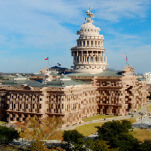Health Workers, Humanitarian Agencies Demand Israel Let Them Enter Gaza Amid Ceasefire
In addition to immediate aid, other advocates say, "If we want peace, we also need to demand justice."
In Depth
On Wednesday, Israeli and Hamas officials announced they’ve reached a ceasefire deal to stop the hostilities in Gaza and facilitate the release of hostages from both sides over the coming weeks. The announcement comes after 15 months of genocide perpetrated by Israeli forces, and seemingly endless carnage and destruction that the U.S. aided and abetted every step of the way. Now, as Palestinians in Gaza cautiously celebrate some respite from over a year of terror, humanitarian agencies and health care workers are pleading with Israel to allow aid to enter Gaza—and for the ceasefire to be permanent.
Since the deal was announced, the photos and videos of Palestinians, including small children, crying and celebrating in the streets of Gaza, are both beautiful and devastating. Some videos show toddlers dancing and in tears from relief, recorded in the tents and refugee camps in which they live after losing everything. Other videos show journalists—who were widely targeted by Israeli forces—removing their helmets at the news, to loud cheers from those around them. One journalist shared a video he pre-recorded in the event of his death, which he expected after Israeli forces killed over 150 Palestinian journalists in Gaza over the last year.
Still, there’s reason to be cautious. The deal, which will unfold in three phases, is set to begin on January 19. But on Thursday, an Israeli cabinet meeting in which the government was expected to approve the deal was delayed, with Prime Minister Benjamin Netanyahu blaming Hamas. Early Thursday, the outlet reported that Israeli attacks killed 82 Palestinians in Gaza in the hours since a ceasefire was announced. Further, “Israel has a very prolonged history of violations regarding commitment to ceasefire agreements,” according to Abu Azzoum, a reporter for Al Jazeera. But if the deal goes through, Azzoum wrote, it’s estimated that approximately 600 humanitarian aid trucks will enter Gaza on a daily basis.
UNICEF has stressed that Israeli forces must immediately allow all aid and aid workers to enter Gaza, and lift the restrictions they’ve imposed over the last 15 months, blocking food and medical supplies—particularly from entering northern Gaza. Israeli forces have long claimed that these restrictions were necessary to stop supplies from reaching Hamas fighters. All this achieved was mass starvation and surgeries without anesthetic or proper sanitation supplies, doctors and humanitarian agencies say.
“Tens of thousands of women and girls have been killed and injured in Gaza… and without access to critical care and basic services. Women have been forced to give birth without medical help amid bombs and destruction. Nine people out of ten in Gaza cannot fulfill their daily food needs,” Dr. Natalia Kanem, executive director of the United Nations Population Fund said in a statement, adding that “the ceasefire deal offers a glimmer of hope.” She also called on “all parties” to “facilitate immediate, unhindered and scaled-up humanitarian access to enable UNFPA and its partners to provide critical assistance to all civilians in need across Gaza.”
Palestinian children celebrating the ceasefire. My heart is so full. 🥹 pic.twitter.com/utQLiEsm6n
— missfalasteenia (@missfalsteenia) January 15, 2025
-

-

-

-

-

-

-

-

-

-

-

-

-

-

-

-

-

-

-

-

-

-

-

-

-

-

-

-

-

-

-

-

-

-

-

-

-

-

-

-








































